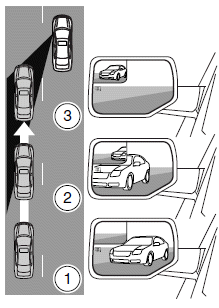Blind spot mirrors
Blind spot mirrors have an integrated convex spotter mirror built into the upper outboard corner of the outside mirrors. They are designed to assist the driver by increasing visibility along the side of the vehicle. For more information on your side view mirrors, refer to Exterior mirrors in the Driver Controls chapter.
Driving with blind spot mirrors
Before a lane change, check the main mirror first, then check the blind spot mirror. If no vehicles are present in the blind spot mirror and the traffic in the adjacent lane is at a safe distance, signal that you are going to change lanes. Glance over your shoulder to verify traffic is clear, and carefully change lanes.
When the approaching vehicle is at a distance, its image is small and near the inboard edge of the main mirror. As the vehicle approaches, the image becomes larger and begins to move outboard across the main mirror (1). As the vehicle approaches its image will transition from the main mirror and begin to appear in the blind spot mirror (2).
As the vehicle leaves the blind spot mirror it will transition to the driver’s peripheral field of view (3).

![]() WARNING:
Objects in the blind spot mirror are closer than they appear.
WARNING:
Objects in the blind spot mirror are closer than they appear.
See also:
Rear seats
WARNING: To prevent possible damage to the seat or safety belts, make
sure that the safety belts are not buckled when folding the seat back.
• Recline seat back: With the seat occupied, pull th ...
Dual automatic temperature control system (with sony® audio system)
Note: You can switch temperature units between Fahrenheit and Celsius.
See Menu features in the MyFord Touch or MyLincoln Touch chapter.
A. CLIMATE: Press to turn the climate control system off an ...
Driver and passenger airbags
WARNING: Never place your arm or any objects over an airbag module. Placing
your arm over a deploying airbag can result in serious arm fractures or other injuries.
Objects placed on or over the ai ...
